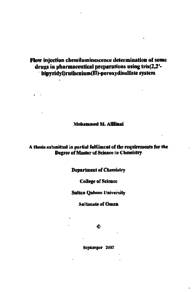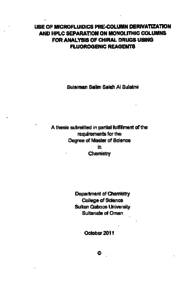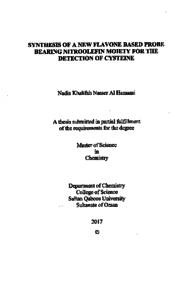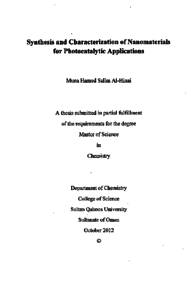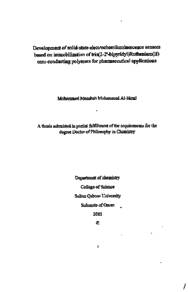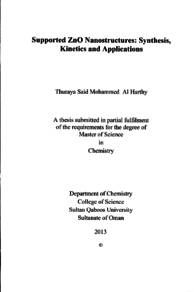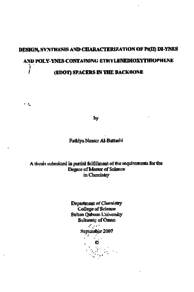Document
Flow injection chemiluminescence determination of some drugs in pharmaceutical preparations using tris(2,2' bipyridyl)ruthenium(II)-peroxydisulfate system
Publisher
Sultan Qaboos University
Gregorian
2007
Language
English
Subject
English abstract
A novel flow injection method was developed for the determination of Penicillamine (PA), Ephedrine (EP) and chlorpheniramine (CPA). The method is based on the reaction of each analyte with tris(2,2'-bipyridyl) ruthenium (II) (Ru(bipy)32+) and peroxydisulfate in the presence of light to produce chemiluminescence, PA and EP were determined after derivatization with acetaldehyde and formaldehyde respectively. This derivatization step results in significant enhancement of the chemiluminescence signal, leading to the better sensitivity and lower detection limits. The FI configuration consisted of a multiposition (eight ports) valve and a syringe pump for aspiration of the reagents ( ruthenium complexes and peroxydisulfate) and a peristaltic pump used to propel the sample solution. Experimental factors that influence the derivatization reaction and the CL reaction were systematically optimized. Under the optimum conditions, linear calibration curves between 0.2 - 24 ppm, 0.2 - 20 ppm, 0.1 -14 ppm, for PA, EP and CPA were obtained. The detection limits were 0.1ppm, 0.03 and 0.01 ppm for PA, EP and CPA respectively. For the first time, the oxidation of tris(1,10-phenanthroline) ruthenium(II) by peroxydisulfate in the presence of light was used to determine CPA. The calibration curve was linear between 0.1 - 10 ppm and detection limit of 0.04 ppm for CPA was obtained. When applied to pharmaceutical formulations, the procedures were found to be free from interferences from common excipients except chlorpheniramine in syrup where we apply standard addition. The results obtained for the assay of commercial formulations demonstrated good accuracy and precision.
Member of
Resource URL
Arabic abstract
طريقة جديدة مميزة تم إبتكارها باستخدام طريقة الحقن الإنسيابي لتحليل ثلاثة عقاقير وهي بينيسيلامين ، إفيدرين و كلورفينير امین. الطريقة تستند على تفاعل المواد المراد تحليلها مع مركب الروتينيوم الثنائي ثلاثي البريديل (( tris ( 2 , 2 ' bipyridyl ) ruthenium ( II ) الذي يؤكسد بواسطة البروكسي دي سلفات (peroxydisulfate) وبوجود الضوء كعامل مساعد الإنتاج وميض ضوئي. تم إشتقاق كل من بينيسيلامين و إفيدرين مع الاسدالدهيد والفورم الدهيد على التوالي وتحت الظروف المعيارية لكل من تفاعل الإشتقاق والتفاعل مع العامل الضوئي ، كانت المنحنيات المعيارية خطية ما بين 0 . 2 و 24 مايكروجرام في المليلتر للبينيسيلامين ، و 0 . 2-20 مايكروغرام في المليلتر للإفيدرين و0 . 1-10 ميكروغرام في المليلتر. وقد كان الحد الأدنى للكشف للبينيسيلامين 0 . 1 ميكروغرام في الميلتر و 0 . 03
ميكروغرام في المليلتر للإيقدرين و 0 . 01 ميكروغرام المليلتر الكلورفينير أمين.
وللمرة الأولى تم أكسدة مركب الروتينيوم الثنائي ثلاثي فيننفثارل ( tris ( 1 , 10 - phenanthroline ) ruthenium ( II بواسطة البروكسي دي سلفات وبوجود الضوء كعامل مساعد لانتاج وميض ضوئي. وتحت الظروف المعيارية كانت المنحنيات المعيارية خطية مابين 0 . 1 و10 ميكروغرام في المليلتر والحد الادنى 0 . 04 ميكروغرام في المليلتر للكلورفينير أمين. هذا وقد تم تطبيق هذه الطرق لتحليل هذه المواد في المستحضرات الطبية وكانت النتائج دقيقة ومتوافقة مع المقادير المسجلة لهذه الأدوية في مستحضراتها، ولم يكن هناك تداخل للمواد الأخرى الموجودة في هذه المستحضرات وبين المركب المراد تحليله ، عدا الكلورفينير أمين في مستحضر محلول الشراب ، حيث تم استخدم مبدا أضافة كمية من المادة المعيارية لتحليل هذا المركب في مستحضر الشراب.
ميكروغرام في المليلتر للإيقدرين و 0 . 01 ميكروغرام المليلتر الكلورفينير أمين.
وللمرة الأولى تم أكسدة مركب الروتينيوم الثنائي ثلاثي فيننفثارل ( tris ( 1 , 10 - phenanthroline ) ruthenium ( II بواسطة البروكسي دي سلفات وبوجود الضوء كعامل مساعد لانتاج وميض ضوئي. وتحت الظروف المعيارية كانت المنحنيات المعيارية خطية مابين 0 . 1 و10 ميكروغرام في المليلتر والحد الادنى 0 . 04 ميكروغرام في المليلتر للكلورفينير أمين. هذا وقد تم تطبيق هذه الطرق لتحليل هذه المواد في المستحضرات الطبية وكانت النتائج دقيقة ومتوافقة مع المقادير المسجلة لهذه الأدوية في مستحضراتها، ولم يكن هناك تداخل للمواد الأخرى الموجودة في هذه المستحضرات وبين المركب المراد تحليله ، عدا الكلورفينير أمين في مستحضر محلول الشراب ، حيث تم استخدم مبدا أضافة كمية من المادة المعيارية لتحليل هذا المركب في مستحضر الشراب.
Category
Theses and Dissertations

